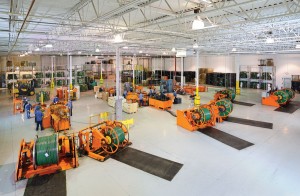The following is a list of basic formulas for 270 ksi, 7-wire Prestressing steel strand (per ASTM-A416) used in Post-Tensioned concrete.
_______________________________
Assume 0.5″ diameter strand has cross-sectional area of 0.153 sq.in. and weight of 0.525 lbs/ft.
Assume 0.6″ diameter strand has cross-sectional area of 0.217 sq.in. and weight of 0.740 lbs/ft.
_______________________________
Minimum Ultimate Tensile Strength (MUTS) = (Grade of Steel) x (Cross-Sectional Area)
0.5″ inch diameter = (270 ksi) x (0.153 sq.in.) = 41.3 kips
0.6″ inch diameter = (270 ksi) x (0.217 sq.in.) = 58.6 kips
_______________________________
Minimum Yield Strength = 90% of MUTS = MUTS x 0.90 (per ASTM-A416)
0.5″ inch diameter = (41.3 kips) x (0.90) = 37.2 kips
0.6″ inch diameter = (58.6 kips) x (0.90) = 52.7 kips
_______________________________
Jacking Force = 80% of MUTS = MUTS x 0.80 (per ACI Code)
0.5″ inch diameter = (41.3 kips) x (0.80) = 33.0 kips
0.6″ inch diameter = (58.6 kips) x (0.80) = 46.9 kips
“Jacking Force” is the force that tendons are stressed to.
_______________________________
Allowable Initial Force = (Jacking Force) minus (Short-Term Losses) = 70% of MUTS = MUTS x 0.70 (per ACI-318)
Short-Term Losses include:
- Angular Profile of Tendon
- Horizontal sweeps in Tendon
- Wedge-Seating (typically 0.25 inch)
- Wobble due to installation (CLICK HERE to view the video on how to calculate Angular and Wobble Coefficients in unbonded post-tensioning tendons.)
0.5″ inch diameter = (41.3 kips) x (0.70) = 28.9 kips
0.6″ inch diameter = (58.6 kips) x (0.70) = 41.0 kips
“Initial Force” is the force at the anchorage after the wedges are seated and stressing jack is removed. The calculated values above are approximate since the actual short-term losses may differ from the theoretical values.
_______________________________
Final Force = (Initial Force) minus (Long-Term Losses)
Long-Term Losses include:
- Creep of concrete (permanent deflection due application of constant load)
- Elastic Shortening of concrete
- Relaxation of steel prestressing strand
- Shrinkage of concrete during curing
0.5″ inch diameter = approx 26.9 kips
0.6″ inch diameter = approx. 38.1 kips
“Final Force” is the force at the anchorage after the long-term losses are accounted for. The calculated values above are approximate since the actual long-term losses may differ from the theoretical values.
_______________________________
Average Tendon Elongation (approx.) = (P x L) / (A x E)
P = Prestress jacking force (70% of MUTS)
L = Length of steel (inches)
A = Cross-Sectional Area of steel (sq.in.) on mill certificates
E = Modulus of Elasticity of steel (ksi) on mill certificates
For example, using a 100-foot tendon (L = 100 x 12 inches) with Modulus of Elasticity of 28,500 ksi.
0.5″ inch diameter = (28.9 kips x 1,200 inches) / (0.153 sq.in. x 28,500 ksi) = 7.95 inches
0.6″ inch diameter = (41.0 kips x 1,200 inches) / (0.217 sq.in. x 28,500 ksi) = 7.95 inches
***Notice that the 0.5″ and 0.6″ have the same Avg. Elongation***
_______________________________
Post-Tensioning Institute recommends an allowable elongation range of plus/minus 7% of the Average Tendon Elongation for unbonded post-tensioning tendons.
Min. Allowable Elongation = 93% of Avg. Elongation = 0.93 x (Avg.El.)
Max. Allowable Elongation = 107% of Avg. Elongation = 1.07 x (Avg.El.)
If we use the same 100-foot tendon with average elongation of 7.95 inches, then Min.El. = 0.93 x 7.95 inches = 7.40 inches and Max.El. = 1.07 x 7.95 inches = 8.51 inches.
– Rattan Khosa, Vice President, AMSYSCO
____________________________________________
Copyright © 2010 by AMSYSCO, Inc. All rights reserved.












